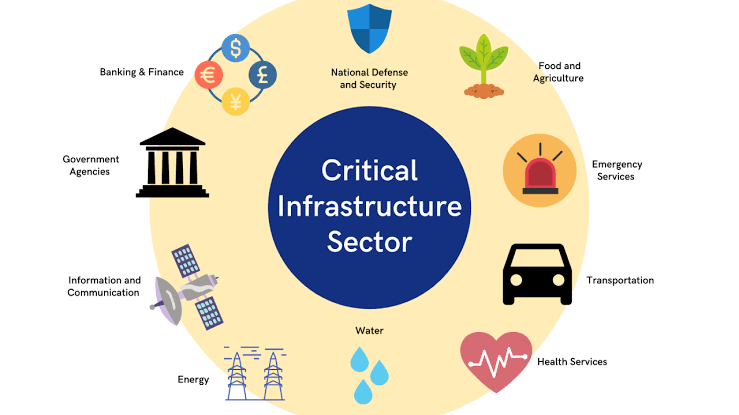In 2025, cybersecurity is very important for protecting key systems like power grids, water plants, transportation, and financial networks. These systems are essential for daily life and must work without interruption. As technology grows, cyber threats become more complex and bigger. Critical systems are often targeted by hackers, including countries, criminal groups, and individuals. Protecting these systems is now crucial for national safety, the economy, and public well-being.
Cybersecurity no longer concerns only IT professionals or large corporations—it has become an essential layer of defense for governments, municipalities, and the global economy. This article explores why cybersecurity is vital for critical infrastructure, the types of threats involved, recent cyber incidents, and the evolving strategies used to protect these essential systems.
What Is Critical Infrastructure?
Critical infrastructure refers to systems and assets that are vital to the functioning of a nation’s economy, public health, and safety. These include sectors like energy, telecommunications, water supply, transportation, healthcare, and finance. Disruption in any of these sectors can lead to widespread chaos and even loss of life. For example, a power outage caused by a cyberattack could shut down hospitals, communication networks, and security systems, creating a domino effect of failures.
With the digitization of these systems, many now rely heavily on operational technologies (OT) and industrial control systems (ICS) that are often connected to the internet. This integration has improved efficiency but also exposed them to new forms of cyber vulnerabilities. Unlike traditional IT systems, many critical infrastructure platforms were not originally designed with cybersecurity in mind, making them especially susceptible to breaches.
Rising Threats in 2025
As of July 2025, cyberattacks on critical infrastructure have grown more frequent and sophisticated. Ransomware attacks on water supply systems, coordinated phishing campaigns against electric grid operators, and state-sponsored espionage targeting nuclear facilities are no longer rare occurrences. In the past year alone, several nations reported cyber intrusions into their national railway networks and aviation control centers.
One particularly alarming trend is the use of artificial intelligence and machine learning by threat actors to bypass traditional security defenses. AI-powered attacks can adapt in real time, evade detection, and exploit zero-day vulnerabilities. Additionally, geopolitical tensions have escalated the use of cyber warfare tactics, with rival nations launching digital attacks as a form of political leverage or economic sabotage.
Real-World Examples of Cyberattacks
Several recent incidents underscore the real and present danger of neglecting cybersecurity in critical infrastructure. In early 2025, a European nation experienced a massive blackout that lasted nearly 48 hours after a coordinated cyberattack on its power grid. Investigations revealed that attackers had gained access through an outdated software vulnerability in a control center, which could have been patched months earlier.
Another notable case involved a ransomware group that targeted a major North American water treatment plant. The attackers demanded millions in cryptocurrency, threatening to disrupt water supply to millions of residents. Though the attack was eventually neutralized, it highlighted how a single point of failure in a cyber network can potentially endanger public health.
The Role of Cybersecurity in Prevention
Cybersecurity acts as the first and often last line of defense against these attacks. It involves not just antivirus software and firewalls, but a comprehensive framework that includes threat detection, incident response, vulnerability management, and user education. For critical infrastructure, the focus must be on both proactive measures and reactive capabilities.
Network segmentation, multi-factor authentication, regular system updates, and endpoint protection are some basic yet essential practices. However, these alone are not enough. Real-time monitoring of network activity, using AI-driven analytics, allows for the early detection of anomalies that may indicate an attack in progress. Moreover, intrusion prevention systems can automatically isolate compromised systems to prevent the spread of malware.
Government Regulations and International Cooperation
Governments worldwide are beginning to recognize the urgency of securing their infrastructure. In 2025, Canada and several other G7 countries revised their national cybersecurity frameworks to include mandatory compliance requirements for operators of critical infrastructure. These policies demand the implementation of minimum cybersecurity standards and regular third-party audits to ensure accountability.
Additionally, international alliances are being formed to share intelligence and coordinate responses to cross-border threats. Organizations like NATO and the United Nations have also intensified their focus on cyber defense as a key aspect of global security. Joint cyber drills and threat-sharing platforms have become standard practice among allied nations.
Challenges in Implementation
Despite the growing awareness, implementing robust cybersecurity strategies across critical infrastructure remains challenging. Many legacy systems are still in use and cannot be easily upgraded without significant downtime or cost. Moreover, the shortage of qualified cybersecurity professionals continues to be a global issue.
Budget constraints, particularly in developing countries, also limit the ability to invest in advanced security technologies. Smaller municipalities and utilities often lack the resources to build resilient cyber defenses, making them easy targets for attackers.
Furthermore, balancing cybersecurity with usability is a constant struggle. Overly strict security protocols can hinder the efficiency of operations, while lax policies can leave systems wide open to attack. This makes the need for smart, adaptive security solutions all the more pressing.
The Path Forward
Looking ahead, the future of cybersecurity in critical infrastructure lies in continuous innovation and cooperation. Integrating cybersecurity into the design phase of all new infrastructure projects will be key. The adoption of zero-trust architecture, where no entity is automatically trusted, can greatly reduce the risk of internal and external threats.
Investment in training and workforce development is equally important. As cyber threats evolve, so too must the skills and awareness of those responsible for defending against them. Public-private partnerships can also play a crucial role in developing cutting-edge technologies and sharing threat intelligence.
Conclusion
The digital transformation of critical infrastructure has brought unprecedented benefits in terms of efficiency and connectivity, but it has also introduced serious risks. Cybersecurity is no longer optional—it is a fundamental necessity for national resilience. As of July 2025, the threat landscape continues to evolve, demanding that governments, private sectors, and communities work together to fortify their defenses.
By prioritizing cybersecurity, adopting forward-thinking policies, and investing in advanced technologies, societies can protect their most vital systems from disruption. The cost of inaction is simply too high, and the time to act is now.



